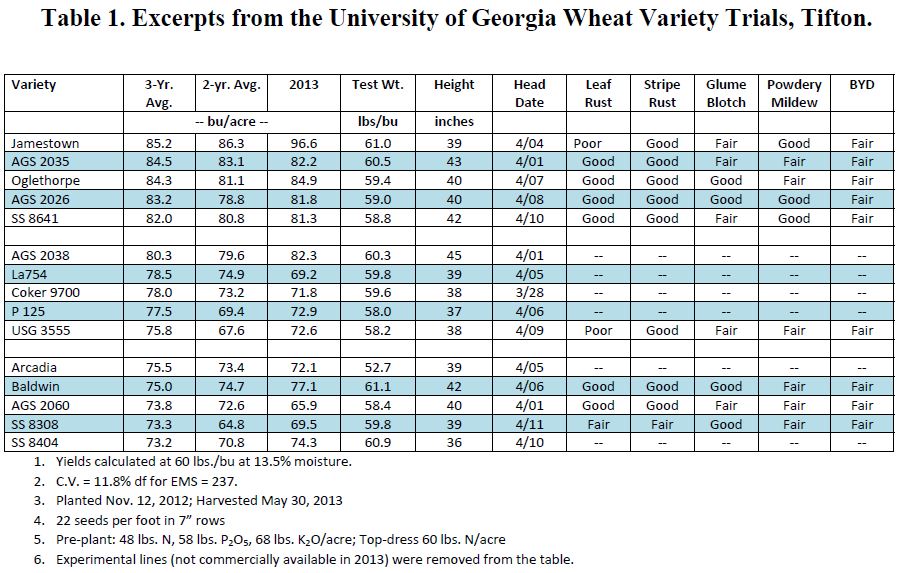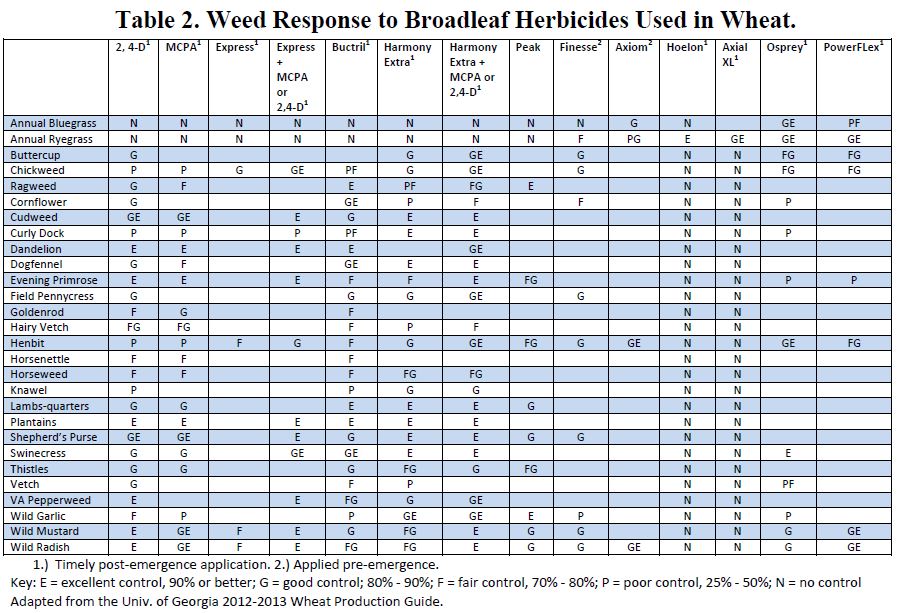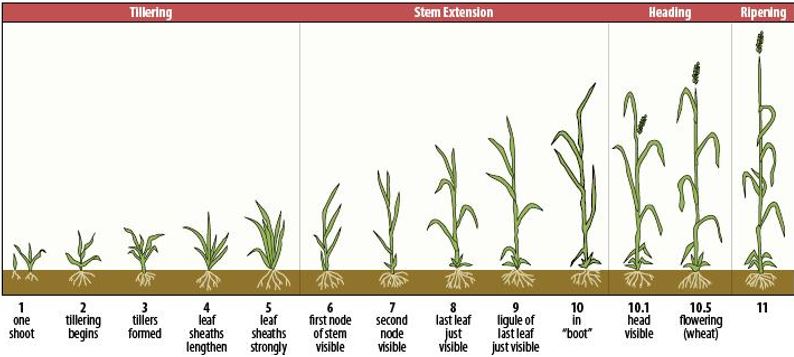Variety selection is one of the most important decisions in small grains production. Growers should choose varieties with a high yield potential, good disease resistance and high test weights.
Table 1 shows excerpts from the UGA, 2012-2013 Small Grains Performance Test for wheat at Tifton, GA.
Planting
Wheat, rye, and oats grown for grain should be planted into a well prepared seedbed or, if using a no-till drill, may be directly planted without tillage. Small grain roots can be easily inhibited by hardpans or plow layers, so deep tillage may be necessary if hardpans exist in a field.
The optimum time to plant small grains for grain production in North Florida is November 7 – December 15. It is important to plant full season varieties in the early part of the range to ensure the crop receives enough cool weather to properly vernalize. Insufficient vernalization will reduce seed head formation. Additionally, do not plant early season varieties at the beginning of the planting window as they may head out too early and be damaged by a late frost.
Seeding Rate
Seeding rates for various small grains are similar, however there are large differences in how much a bushel of each crop and variety within a crop, weigh.
The old rule of thumb was to plant wheat at two bushels per acre. However, because of the major differences in seed weight among varieties, it is better to plant based on the number of seeds per square foot.
The recommended rate is to plant 30-35 seeds per square foot. If you are using a grain drill with six to eight inch row spacing, this would be 18 – 23 seeds per foot of row, in order to plant 30 seeds per square foot. The optimum planting depth is between 1.0 and 1.5 inches. Seeding rate should be increased by ten to 15 percent if planting in December.
| Row Width |
Seeds per square foot |
|||
|
|
30 |
35 |
40 |
45 |
|
Seeds per linear foot |
||||
|
6” |
15 |
18 |
20 |
23 |
|
7” |
18 |
20 |
23 |
26 |
|
7.5” |
19 |
22 |
25 |
28 |
|
8” |
20 |
23 |
27 |
30 |
Adapted from 2013 Alabama Winter Wheat Production Guide
Fertilization
Nitrogen (N) is a key nutrient for grain production. A pre-plant application of 20-30 pounds N per acre followed by 70-90 pounds applied around Feekes-3, which generally occurs between the last week of January and first ten days of February, produces good yields. (Feekes is a scale of wheat development used to describe growth stage of the wheat crop.) On sandier soils it may be beneficial to use split applications, applying 60 pounds of N in late January, followed by another 40-60 pounds in mid to late February.
Late applications of N (stem elongation or later) generally do not increase yield, but can lower test weights and increase foliar disease. Total N applications over 120 pounds per acre have not been shown to be beneficial and can increase lodging, reduce grain quality, and delay maturity.
Sulfur (S) applications may increase yields on sandier soils, where S is not as available. Top-dressing 15-20 pounds per acre with N should be adequate.
Phosphorous (P) and Potassium (K) are essential for high grain yields. A soil test is the most accurate method to determine P and K requirements. The majority of plant uptake for these nutrients occurs early in the plant’s development, therefore, it is important that these nutrients be applied at planting.
Lime should be applied prior to planting to achieve the target pH of 6.0.
Weed Control
Planting into a weed-free seed bed is essential to establishing a stand of small grains. The best way to accomplish this is with tillage or burn-down herbicide applications. Additionally, there are several herbicides that can be used once the crop has emerged, but most must be applied early in the season, before jointing occurs.
Wheat and other small grains can be injured by some herbicides, if they are not applied during the correct growth stage, or at the correct rate. See the table below for the effectiveness of various herbicides on winter weeds.
Feekes Scale
The Feekes scale of wheat development is a common tool used to describe the growth stage of a wheat crop. Adapted from University of Kentucky Ag Extension. See below.
Download a printer firendly, pdf version of this article: 13 Wheat Production Guide For additional information, see the UGA Wheat Production Guide or contact your local UF/IFAS Extension Agent.
- Carinata Starting to Come Up in Jackson County - December 12, 2014
- Wheat Production Considerations for 2014-2015 - November 10, 2014
- Peanut and Cotton Harvest Video 2014 - November 10, 2014




